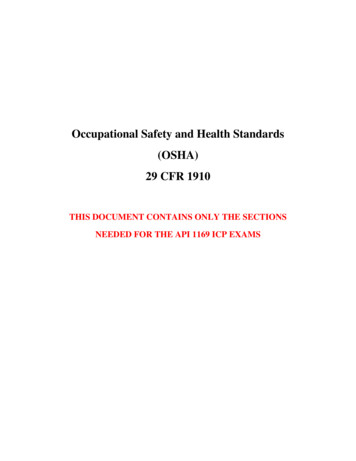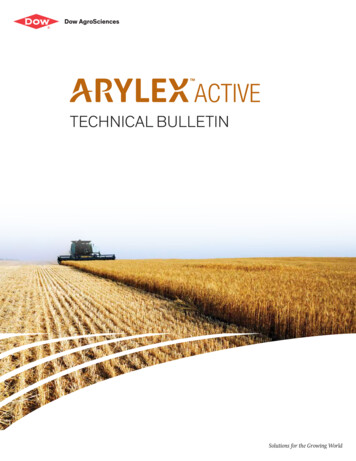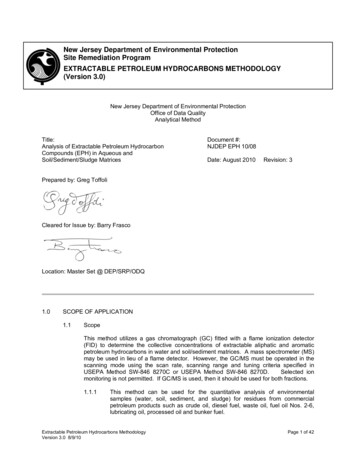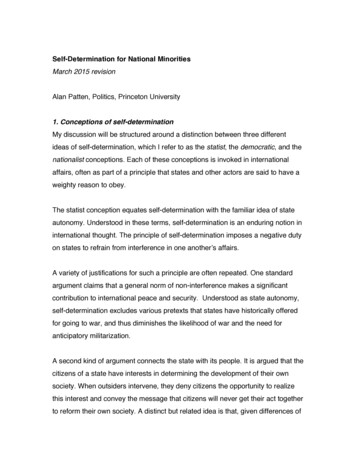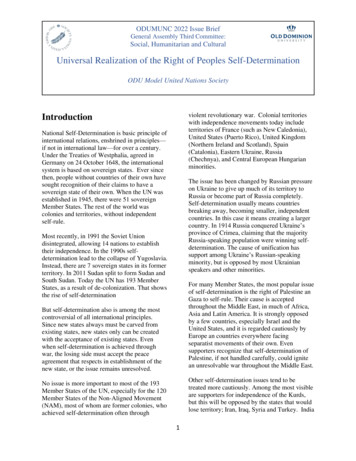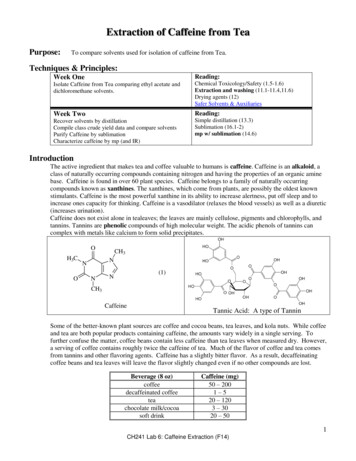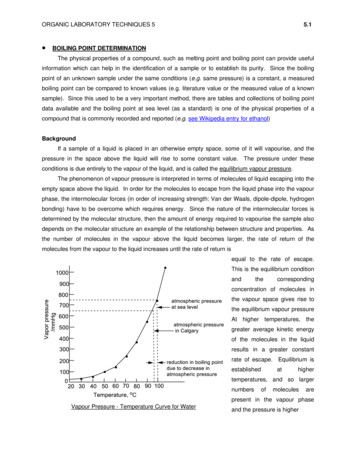
Transcription
ORGANIC LABORATORY TECHNIQUES 5 5.1BOILING POINT DETERMINATIONThe physical properties of a compound, such as melting point and boiling point can provide usefulinformation which can help in the identification of a sample or to establish its purity. Since the boilingpoint of an unknown sample under the same conditions (e.g. same pressure) is a constant, a measuredboiling point can be compared to known values (e.g. literature value or the measured value of a knownsample). Since this used to be a very important method, there are tables and collections of boiling pointdata available and the boiling point at sea level (as a standard) is one of the physical properties of acompound that is commonly recorded and reported (e.g. see Wikipedia entry for ethanol)BackgroundIf a sample of a liquid is placed in an otherwise empty space, some of it will vapourise, and thepressure in the space above the liquid will rise to some constant value. The pressure under theseconditions is due entirely to the vapour of the liquid, and is called the equilibrium vapour pressure.The phenomenon of vapour pressure is interpreted in terms of molecules of liquid escaping into theempty space above the liquid. In order for the molecules to escape from the liquid phase into the vapourphase, the intermolecular forces (in order of increasing strength: Van der Waals, dipole-dipole, hydrogenbonding) have to be overcome which requires energy. Since the nature of the intermolecular forces isdetermined by the molecular structure, then the amount of energy required to vapourise the sample alsodepends on the molecular structure an example of the relationship between structure and properties. Asthe number of molecules in the vapour above the liquid becomes larger, the rate of return of themolecules from the vapour to the liquid increases until the rate of return isequal to the rate of escape.This is the equilibrium conditionandthecorrespondingconcentration of molecules inthe vapour space gives rise tothe equilibrium vapour pressureAt higher temperatures, thegreater average kinetic energyof the molecules in the liquidresults in a greater constantrate of escape. Equilibrium isestablishedathighertemperatures, and so largernumbersofmoleculesarepresent in the vapour phaseVapour Pressure - Temperature Curve for Waterand the pressure is higher
ORGANIC LABORATORY TECHNIQUES 55.2When the vapour pressure of a liquid is equal to the atmospheric (or applied) pressure thenboiling occurs. The temperature at which this occurs, for a given pressure, is the boiling point. Itshould be noted, therefore, that the boiling point of a liquid decreases as the atmospheric (or applied)pressure decreases. This is illustrated by the Vapour Pressure-Temperature Curve above. For example,at sea level the atmospheric pressure is 760 mm Hg (also expressed as 760 torr, 101325 Pa, 101.3 kPa,1013.25 mbar or 14.696 psi) and pure water boils at 100 C. However, in Calgary (approx. 1050m abovesea level) the atmospheric pressure is approximately 670 mm Hg, and water boils at about 96.6 C.As a rule of thumb, the boiling point of many liquids will drop about 0.5 C for a 10 mm decrease inpressure in the vicinity of 760 mm Hg. At lower pressures, a 10 drop in boiling point is observed for eachhalving of the pressure. An approximate measure that seems to work relatively well in Calgary forcalculating the boiling point of a liquid in Calgary is to subtract 1 for every 15 of temperature above50 C.So, in order to convert an experimental measurement taken in Calgary (which is at higher altitude thansea level and so is at a lower pressure) to that reported for sea level (higher pressure) one needs to ADDa correction factor since the boiling point at sea level is higher than that at higher altitudes.A more scientific method for correcting boiling point requires knowing the atmospheric pressure (inmmHg), Pobs, when and where the boiling point, BPobs is measured:BPcorr BPobs – (Pobs – 760mmHg) x 0.045 oC/mmHgThis is the method you should use for correcting boiling points. As an example, the boiling point of waterat the summit of Mt Temple (3544m, near Lake Louise, summit pressure approximately 500 mmHg),based on 100 oC at sea level would be:100 oC BPobs – (500 mmHg – 760mmHg) x 0.045 oC/mmHg100 oC BPobs – ( – 260mmHg) x 0.045 oC/mmHg BPobs 11.7 oC/mmHgBPobs 88.3 oCIn order to use this better method for correcting boiling point, one needs to know the atmosphericpressure at the time when the boiling point was measured. Here is the link to the Environment Canadawebsite for that information. This provides you with the required pressure data at the time pf yourlaboratory session. Note that 1 kP 7.50062 ure station.html
ORGANIC LABORATORY TECHNIQUES 55.3At lower pressures, a boiling point nomograph or temperature-pressure alignment chart (shown below)can be used.A pressure nomograph, used to correct boiling pointsHow to use the pressure nomograph.The basic principle is that a line through two known points on any two different scales (A,B,C) can beused to read off the value on the third scale.There are two ways in which a pressure nomograph can be used (i) to determine the boiling point atatmospheric pressure (760 mm Hg) given the boiling point at a lower pressure and (ii) to determine theboiling point at a lower pressure given the boiling point at atmospheric pressure.First, let's say we have a compound with a boiling point of 100oC at 1mm Hg pressure. What is the boilingpoint at 760mm Hg?To do this we need to draw a line from 100oC on scale A (left side, observed boiling point) to 1.0 mm Hgon scale C (right side, pressure "P" mm). We can then read off the boiling point at 760 mm on line B, it isabout 280oC.
ORGANIC LABORATORY TECHNIQUES 55.4Using a pressure nomograph:Determining the boiling point at 760mm Hg (scale B) for a sample that boils at 100oC (scale A) at 1mm Hg(scale C)Now what temperature would that same compound boil at 10 mm Hg pressure? Now we draw a line thatpasses through 280oC on scale B (middle scale, the boiling point at 760mm Hg) and to 10mm Hg onscale C. By extending that line to scale A, we can read off the new boiling point on scale A (left side) asbeing about 140oC.Of course, you don't really have to "draw" the line, it can be done just using the edge of a ruler orsomething else straight.
ORGANIC LABORATORY TECHNIQUES 55.5Using a pressure nomograph:Determining the boiling point (scale A) at 10mm Hg (scale C) for a sample that boils at 280oC at 760mmHg (scale B)It is also sometimes necessary to apply a thermometer "stem correction" (due to the small thermalcontact area and the difference in the coefficient of expansion of mercury or other liquid in a conventionalthermometer and the glass). For more information on the thermometer stem correction, see Pasto andJohnson, "Laboratory Text for Organic Chemistry", Prentice Hall.Boiling point can be determined in a few different ways. If a reasonably large volume of sample isavailable, then the boiling point of the liquid can be determined using a simple distillation apparatus setup (see simple distillation, technique T.6). However, when large volumes are not available, alternativeexperimental procedures have to be used. The micro-boiling point method described below can becarried out with just a few mL of a liquid sample and is a reasonably accurate and convenient way todetermine the boiling point.
ORGANIC LABORATORY TECHNIQUES 55.6Micro-Boiling Point DeterminationMicro reflux methodHot apparatus !The stirrer bar is important to avoid “bumping” of hot liquidSet up and use apparatus in a fumehoodThe sample liquid (approx. 0.5 mL) is introduced into a 150mm diameter test tube using a Pasteurpipette and a small magnetic stirring bar is added. The test tube is placed in the metal heating blockcentered on a hot plate stirrer and carefully clamped in place. The thermometer is clamped in a smallpiece of rubber tube and lowered in to place such that the bulb or tip of the thermometer is about 1 cmabove the surface of the liquid.Once the set-up is complete, turn on the stirrer to give gentle stirring of the liquid and then start toheat. Look for the liquid to be boiling (bubbles) and just above the liquid, the vapour condensing andrunning back into the boiling liquid (i.e. the liquid is refluxing). This is often visible as a ring of liquid on thewalls of the glass. The bulb or tip of the thermometer needs to be at the level of this ring for accuratemeasurement. Once the liquid is gently refluxing, the thermometer temperature reading should be fairlystable and correspond to the observed boiling point of the liquid sample. Make sure not to boil thesample dry.stirring).Once the boiling point has been measured, stop heating the metal block (but leave it
ORGANIC LABORATORY TECHNIQUES 55.7The equipment will be HOT!Remove the thermometer assembly and rememberto wipe off the thermometer. Remove the test tubeand stand in a test tube rack and allow to cool.The metal block can be cooled in ice by carefullypicking it up with metal tongs (as shown to the left)or with a heat resistant glove.Remember to make sure to remove the magneticstirrer bar from the boiling point test tube.The explanation of this method is a very simple one. Once a liquid boils, the temperature of thevapour will not increase until all of the liquid has boiled and converted to the vapour phase. Therefore,provided the liquid sample is being heated at reflux, the temperature of the vapour will match the boilingpoint of the liquid.Two problems are common to this method.The first arises when the liquid sample in the test tube is heated too strongly such that it evaporates or isboiled away. This is more likely to be a problem for liquids with low boiling points. Once the test tube andblock have cooled, add more liquid sample to the test tube and resume heating but more gently.Second, for liquids with high boiling points it might be difficult to reach reflux and it might be necessary tomove the tip or bulb of the thermometer closer to the liquid surface.Don't forget to apply a correction due to the reduced atmospheric pressure in Calgary (altitude). Toensure accuracy, you should carry out at least two separate boiling point determinations on your unknownsample.
ORGANIC LABORATORY TECHNIQUES 55.8Thiele tube method (quick link to videos : version 1, version 2)Before using a Bunsen burner make sure all flammable materials (e.g. solvents)are removed from the area around the Bunsen burner. This means not only yourworkspace but also all the students near to you.When using the Bunsen burner, make sure that you adjust it to a small flame.If you are unsure of how to set up and use a Bunsen burner, see the “heat sources” techniques documentand the video on the Bunsen burner.If only small amounts of liquid material areavailable for boiling point determination, then amicro boiling point apparatus based on a Theiletube can be used. The Thiele tube is a glasstube designed to contain heating oil and athermometer to which a micro test tubecontaining the boiling point sample is attached.The shape of the Thiele tube allows forformation of convection currents in the oil whenit is heated. These currents maintain a fairlyuniform temperature distribution throughout theoil in the tube. The side arm of the tube isdesignedtogeneratetheseconvectioncurrents and thus transfer the heat from theflame evenly and rapidly throughout theheating oil.Don’t clamp the Thiele tube tootightly otherwise it might crack as it expands asit is heated, yet of course it needs to be secure.The sample liquid is introduced by Pasteur pipette into a micro test tube (no more than 0.5ml, which isabout 10mm depth in the small test tube), and a piece of melting point capillary tubing (sealed at one end)is dropped in with the open end down. The micro test tube assembly is then attached to a thermometerwith a rubber band or a thin slice of rubber tubing. The whole unit is then placed in a Thiele tube.
ORGANIC LABORATORY TECHNIQUES 55.9The placement of the test tube / thermometer unit in the Theile tube isimportant:i. the micro test tube should be on the same side of the Thieletube as the elbowii. neither the test tube nor the thermometer bulb should betouching the glass walls of the Thiele tubeiii. the base of the micro test tube should be just below the joint tothe upper part of the elbow (see photograph above)iv. the rubber band should be placed well above the level of the oilin the Thiele tube, and,v. the oil level should be just above the top of the top elbow joint.If the rubber band enters the oil, the band may soften and breakin the hot oil allowing the micro test tube to fall into the oil.When positioning the band, one should bear in mind that the oilwill expand when it is heated.Once the set up has been complete, the lower part of the side arm of the Thiele tube is carefullyheated with a small flame from the Bunsen burner moving the flame back and forth along the arm.During the heating, there is an initial stream of bubbles as air is expelled and then, a little later, a rapidand continuous stream of bubbles emerges from the inverted capillary tube. At this point stop heating.Soon the stream of bubbles will slow down and stop. When they stop, the liquid sample will be drawn upin to the capillary tube. The moment when the liquid enters the capillary corresponds to the boiling pointof the liquid, and the temperature should be recorded.The explanation of this method is a reasonably simple one. During the initial heating, the airtrapped in the capillary tube expands and leaves the tube and vapour from the liquid also enters the tube.There is always vapour in equilibrium with a heated liquid. This gives rise to the initial stream of bubbles.When the temperature reaches the boiling point, the vapour pressure inside the capillary tube equals theatmospheric pressure. As the temperature rises just above the boiling point then the vapour will start toescape : the second set of bubbles. Once the heating is stopped, the only vapour left in the capillarycomes from the heated liquid which seals its open end. As the liquid cools, its vapour pressure willdecrease and when the vapour pressure drops just below atmospheric pressure, the liquid will be drawninto the capillary tube (forced there by the higher atmospheric pressure).Two problems are common to this method. The first arises when the liquid sample in the micro testtube is heated so strongly that it evaporates or is boiled away. Once the oil has cooled, add more liquidsample to the small test tube and resume heating but more gently. The second arises when the liquid isnot heated above its boiling point. If the heating is stopped at any point below the boiling point of the
ORGANIC LABORATORY TECHNIQUES 5105.liquid, the liquid will enter the tube immediately. It will enter the tube because the trapped vapour willhave a pressure less than that of the atmosphere.Here are links to two very similar videos showing how to carry out a micro boiling point determination,version 1, version 2 (newer).Don't forget to apply a correction due to the reduced atmospheric pressure in Calgary (altitude). Toensure accuracy, you should carry out at least two separate boiling point determinations on your unknownsample.
- 760mmHg) x 0.045 oC/mmHg This is the method you should use for correcting boiling points. As an example, the boiling point of water at the summit of Mt Temple (3544m, near Lake Louise, summit pressure approximately 500 mmHg), based on 100 oC at sea level would be: 100 oC BP obs - (500 mmHg - 760mmHg) x 0.045 oC/mmHg 100 oC BP obs



